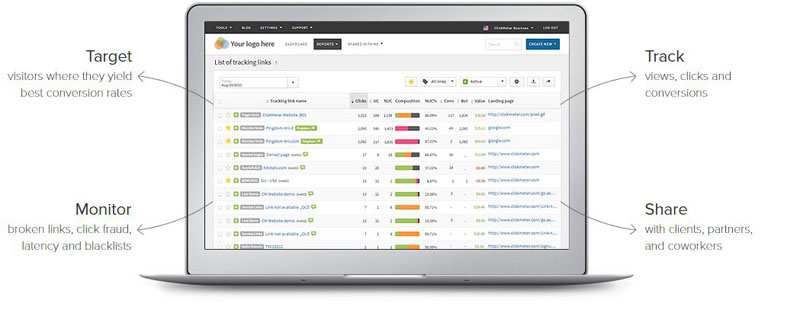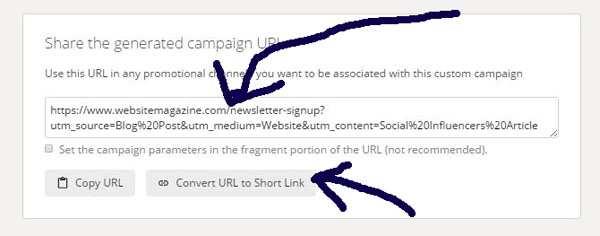How to Track Influencer Marketing ROI

Influencer marketing is only as effective as a company's ability to track it, however, so let's take a look at some ways to measure the return on investment for this popular strategy.
A Unique Link
Retailers can provide influencers with a unique link that can be tied to their referrals. For instance, a blogger can use the link within their blogs, social posts, profiles and other channels they are active on in order to increase the chances of it being clicked and the desired conversion being completed.
Merchants can use a service like ClickMeter to create a tracking link, view the results (like clicks and conversions) and even compare campaigns.

Another way to provide unique URLs rich with source information is through Google's Campaign URL Builder. While Conversion events (purchase, download, subscription) have to be pre-built within Google Analytics, the URL builder can complement those initiatives by confirming what happens after the unique link is shared. Types of insights provided include: number of new sessions, bounce rate and average session duration as well as (depending on Conversion goals) conversion rate, transactions, revenue, goal completions, etc.
The actual URL won't be pretty (see image), so make sure to shorten the URL (preferably with a vanity link like wsm.co/xxxxx for Website Magazine, for instance, rather than buff.ly/xxxxx) before sharing with an influencer so they can easily use the link within their marketing efforts.

A Custom Promo Code
Perhaps the most-used tracking technique for influencer marketing is that of the custom promo code, which is unique to the specific blogger, celebrity, social star or industry mover and shaker - typically for a fixed dollar amount or a percentage off a purchase.
Hello Fresh, for example, works with a lot of reality-based talent (like Ashley I. from the Bachelor franchise) and provides custom promo codes to track their sales.

Most e-commerce platforms provide the functionality to create unique promo codes very easily (and track how often the coupon is redeemed) but some limit the number of active promotions at one time. While a marketer doesn't want to put all their digital eggs in one basket, it's smart not to have too many active influencer campaigns so that campaigns are measured in a way that can inform a brand if they should work with the influencer again, when they see peak sales, etc.
Since most influencers (like reality-based talent) are not working on a commission-only basis but rather have set fees for posts, Snaps, videos, etc. (as told to us for this article), that likely deters smaller brands from working with multiple influencers simultaneously anyway. It's supply and demand, according to agent Paul Desisto of CEG Talent, and influencers are in enough demand to not need to work on commission (some charging tens of thousands of dollars for Instagram posts).
An Isolated Campaign
While not the most savvy of ways to track sales coming from influencers, companies can set specific times for an influencer to post to social or schedule a blog and then monitor website traffic and sales immediately after a post and for a few days after that and compare those numbers to previous metrics prior to bringing on an influencer. The downfall though, is not being able to say with certainty that the revenue came from the influencer. What's more, the brand won't be able to tell if any future sales could be credited to them either (just think of the recurring revenue influencers can bring to subscription-based services like the aforementioned Hello Fresh box).
A Report or Two
Social networks are getting much more generous with the analytics they offer business pages (like demographic info, post reach, engagement, likes, views, etc.). One of the top reasons that influencer marketing is so effective, however, also works against it when it comes to getting direct metrics.
Since organic reach (the number of people who see a post without paid distribution) for brands is dismal across networks, influencers help businesses reach potential customers because they are not traditional business profiles (therefore their organic reach is likely less restricted) and they have engaged followings. If they do not have traditional business profiles, however, they are unable to access the same analytics a company would. In the event they do have access to analytics (like if they use a social media management solution or are promoting a brand on networks like Twitter that give everyone some basic metrics), brands should be asking for reports (even if those are just screenshots of the available analytics).

If direct analytics like those provided within social media networks is what a brand is truly after, they could consider giving the influencer an advertising budget, which will then give them access to much more robust metrics (like conversion rates) from the networks themselves. It might seem counterproductive to layer one advertising campaign (the social influencers themselves) with another (like promoted posts or Instagram ads) but if spending - what is typically a pretty nominal amount - gets a brand to its goal quicker, they can consider it part of the investment when calculating ROI.
A Software Offering
Brands can reach out to influencers on their own, they can contact an influencer's agent or they can leverage a service like Popular Pays or Social Bluebook, which will do much of the outreach and monitoring for them ( read more here).Similarly, it should be noted that employees can often be a company's social media influencers. SMARP provides a platform to suggest content for them to share, reward them for when they do and track their posts for traction.
Admin users can access the company’s analytics, which shows a breakdown of clicks and calculated earned media value (how much money they would have spent if they promoted posts, used LinkedIn advertising, etc.). Companies know how much they pay for SMARP and can see how much they would have paid to get the same reach. This is where many marketers today, however, typically end their social calculations. SMARP helps them go a step further (like everyone should) and feeds the data into the company’s website analytics provider of choice and by using UTM tags allows brands to see how long visitors spent on the site, which pages they visited, and if they completed any goals or conversions, applied for a position or bought something.
Employee advocacy programs help employees boost individual goals: sales can make more sales, HR can make more hires and content creators can get more page views.
Are you running an influencer marketing campaign? Let us know in the comments below. If not, what's holding you back? We'd love to hear about that, too.

Subscribe to Our Newsletter!
Latest in Social Media










